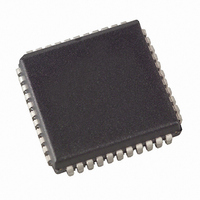AT80C51RD2-SLRUM Atmel, AT80C51RD2-SLRUM Datasheet - Page 56

AT80C51RD2-SLRUM
Manufacturer Part Number
AT80C51RD2-SLRUM
Description
IC MCU 80C51 HI PERFORM 44PLCC
Manufacturer
Atmel
Series
80Cr
Datasheet
1.AT80C51RD2-RLRUM.pdf
(81 pages)
Specifications of AT80C51RD2-SLRUM
Core Processor
8051
Core Size
8-Bit
Speed
40MHz
Connectivity
UART/USART
Peripherals
POR, PWM, WDT
Number Of I /o
32
Program Memory Type
ROMless
Ram Size
1K x 8
Voltage - Supply (vcc/vdd)
2.7 V ~ 5.5 V
Oscillator Type
Internal
Operating Temperature
-40°C ~ 85°C
Package / Case
44-PLCC
Processor Series
AT80x
Core
8051
Data Bus Width
8 bit
Data Ram Size
1280 B
Interface Type
UART, SPI
Maximum Clock Frequency
60 MHz
Number Of Programmable I/os
32
Number Of Timers
3
Operating Supply Voltage
2.7 V to 5.5 V
Maximum Operating Temperature
+ 85 C
Mounting Style
SMD/SMT
3rd Party Development Tools
PK51, CA51, A51, ULINK2
Minimum Operating Temperature
- 40 C
Package
44PLCC
Device Core
8051
Family Name
AT80
Maximum Speed
40 MHz
Lead Free Status / RoHS Status
Lead free / RoHS Compliant
Eeprom Size
-
Program Memory Size
-
Data Converters
-
Lead Free Status / Rohs Status
Details
Available stocks
Company
Part Number
Manufacturer
Quantity
Price
Company:
Part Number:
AT80C51RD2-SLRUM
Manufacturer:
Atmel
Quantity:
967
14. Power Management
14.1
14.2
56
Idle Mode
Power-down Mode
AT80C51RD2
An instruction that sets PCON.0 indicates that it is the last instruction to be executed before
going into Idle mode. In Idle mode, the internal clock signal is gated off to the CPU, but not to the
interrupt, Timer, and Serial Port functions. The CPU status is preserved in its entirety: the Stack
Pointer, Program Counter, Program Status Word, Accumulator and all other registers maintain
their data during idle. The port pins hold the logical states they had at the time Idle was acti-
vated. ALE and PSEN hold at logic high level.
There are two ways to terminate the Idle mode. Activation of any enabled interrupt will cause
PCON.0 to be cleared by hardware, terminating the Idle mode. The interrupt will be serviced,
and following RETI the next instruction to be executed will be the one following the instruction
that put the device into idle.
The flag bits GF0 and GF1 can be used to give an indication if an interrupt occurred during nor-
mal operation or during idle. For example, an instruction that activates idle can also set one or
both flag bits. When idle is terminated by an interrupt, the interrupt service routine can examine
the flag bits.
The other way of terminating the Idle mode is with a hardware reset. Since the clock oscillator is
still running, the hardware reset needs to be held active for only two machine cycles (24 oscilla-
tor periods) to complete the reset.
To save maximum power, a power-down mode can be invoked by software (refer to
12, PCON register).
In power-down mode, the oscillator is stopped and the instruction that invoked power-down
mode is the last instruction executed. The internal RAM and SFRs retain their value until the
power-down mode is terminated. V
reset or an external interrupt can cause an exit from power-down. To properly terminate power-
down, the reset or external interrupt should not be executed before V
operating level and must be held active long enough for the oscillator to restart and stabilize.
Only external interrupts INT0, INT1 and Keyboard Interrupts are useful to exit from power-down.
Thus, the interrupt must be enabled and configured as level - or edge - sensitive interrupt input.
When Keyboard Interrupt occurs after a power-down mode, 1024 clocks are necessary to exit to
power-down mode and enter in operating mode.
Holding the pin low restarts the oscillator but bringing the pin high completes the exit as detailed
in
two inputs is held low and power-down exit will be completed when the first input is released. In
this case, the higher priority interrupt service routine is executed. Once the interrupt is serviced,
the next instruction to be executed after RETI will be the one following the instruction that put
AT80C51RD2 into power-down mode.
Figure
14-1. When both interrupts are enabled, the oscillator restarts as soon as one of the
CC
can be lowered to save further power. Either a hardware
CC
is restored to its normal
4113D–8051–01/09
Table 11-


















